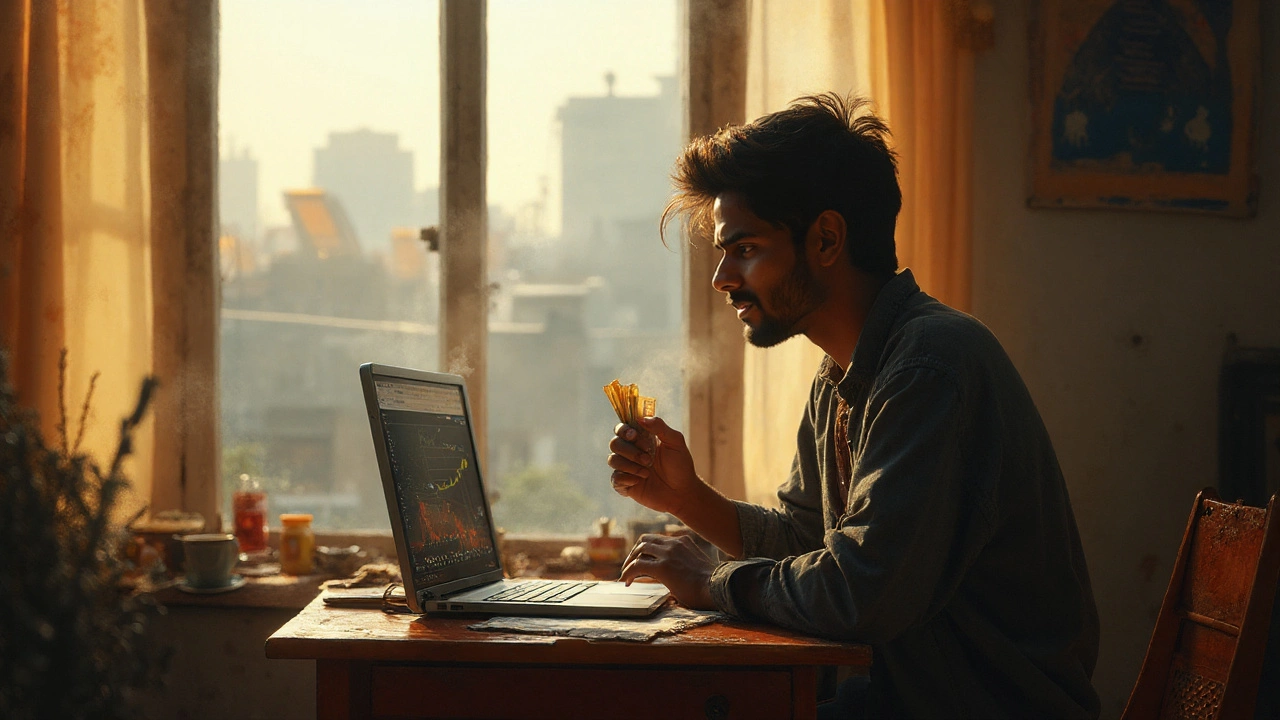If you think you need a fat wallet to get into day trading, think again. Some people log onto broker apps with just $100 hoping to jump into the action. Sounds exciting, right? It also sounds risky as hell. But those TikTok vids showing tiny accounts flipping into thousands probably made you wonder: can you really trade stocks for a living starting out so small, or is it just a fast track to burning cash?
The Realities of Day Trading with Just $100
If you open most day trading forums, you’ll see folks debating whether you can start with a hundred bucks. Some say it’s impossible—brokers eat your money with fees, and you’ll never scale up to anything meaningful. But it’s not impossible, just really, really tough. Here’s the first speed bump: many stock trading platforms in the US have what’s called the Pattern Day Trader (PDT) rule. This rule says if you place more than three day trades in five business days, you need at least $25,000 in your account. If you have less, you get flagged and shut down for a while. Of course, this rule only applies to US-based stocks and brokers, so some people avoid it by using offshore brokers or trading other assets like cryptocurrencies, forex, or even certain penny stocks.
The next catch? Every trade costs you—sometimes a dollar per trade, sometimes less, sometimes more, depending on your broker. If you’re working with $100, and each round trip (buy and sell) costs $2, suddenly 2% of your account is wiped each time you make a trade. Toss in the unpredictable swings of the market, and you start to see the brutal math facing small accounts. According to a 2023 survey from the North American Securities Administrators Association, 95% of inexperienced day traders lose some or all of their money in the first six months. If you’re only risking $100, that might sound like a good thing. But you have to ask: is it possible to climb out of that hole, or is it just entertainment and a way to learn lessons cheaply?
Now, let's talk about leverage—a fancy term that means “trading with borrowed money.” Some brokers, especially those based overseas and crypto platforms, offer crazy high leverage, like 100:1. This means you can buy $10,000 worth of stuff with your hundred bucks. But leverage is a double-edged sword. You could double your money fast… or lose all of it in seconds. One wrong click and your account is zeroed out. A study from the Financial Conduct Authority (UK) in 2023 showed that over 70% of retail investors trading with leverage lose money over time. Over 70%! If that doesn’t tighten your grip on your wallet, nothing will.
So why do people even try? Maybe for practice, maybe for fun, or maybe the same reason people buy lottery tickets. If you treat a $100 trading adventure as part tuition, part entertainment, and part experiment, you’ll probably sleep better. But the odds aren’t good—at least not for getting rich quick.
Platforms and Markets Where $100 Can Actually Trade
Alright, so let’s say you’re set on going for it. Where can you put $100 and actually place trades? Traditional stock brokerages may not be the friendliest place to start. US brokers like Charles Schwab or TD Ameritrade don’t require a minimum deposit, but the PDT rule (remember, the 3 trades per 5 days limit) will cramp your style fast. Some app-based brokers like Robinhood and Webull let you buy stocks and even fractional shares, so you can spread your $100 over a few stocks rather than going all-in on a single one.
But if you want to dodge PDT rules altogether, your options are:
- Forex brokers: This is where a lot of small-budget newbies start. The currency markets are open 24 hours a day, and many brokers let you open an account with just $10. But remember that 70%+ losing statistic from earlier? That definitely applies here too.
- Cryptocurrency exchanges: Binance, Coinbase, or Kraken let you day trade crypto 24/7. You can buy as little as $10 worth of Bitcoin. But fees here are sneaky and add up quickly—and the same risk of wiping out your account with leverage (or even without) is real.
- Contracts for difference (CFD) brokers: Not available in the US, but popular elsewhere, CFDs let you bet on the price movements of stocks, forex, or commodities. The leverage can get wild—and so can your losses.
Are there better alternatives? You might look into simulated trading. Most platforms offer “paper trading” accounts where you practice with fake money. It feels very real, except your stomach doesn’t twist when you lose actual dollars. This is the best way to learn strategies, test discipline, and see if you have the temperament for trading without risking your lunch money. Think of it as playing NBA 2K before challenging LeBron in real life.
If you’re set on going live, here’s a quick rundown of some popular platforms and their essentials:
| Platform | Minimum Deposit | PDT Rule Applies? | Assets | Fees |
|---|---|---|---|---|
| Robinhood (US) | $0 | Yes (for stocks) | Stocks, ETFs, Crypto | $0 commission, but spread/hidden costs |
| Webull (US) | $0 | Yes (for stocks) | Stocks, ETFs, Options, Crypto | $0 commission, $0.01 min trade |
| Binance (Crypto) | $10 | No | Crypto | 0.1% per trade |
| OANDA (Forex) | $1 | No | Forex, Crypto, CFDs (outside US) | Varies by pair, spread based |
| eToro (CFD, Intl) | $10 | No | Stocks, Crypto, Forex, CFDs | Varies, $5 withdrawal fee |
Before you get super excited about zero commissions, know this: there are always “hidden costs.” This comes through spreads (difference between buy and sell price) or other sneaky fees. It all adds up, especially with small cash.

Risk Management: Why 0 Gets Eaten Up Fast
Here’s something the pros all agree on: managing risk is everything. When you’ve got a $100 account, one emotion-fueled bad trade can wipe out your whole day. Or week. Or all of it. The math is brutal. Imagine you blow $10 on a trade. Suddenly, you’re down 10%. To get back to even, you need to make more than 10% on your next trade, which gets harder and harder every time.
Fact: most successful traders, even those with huge bankrolls, risk less than 1% of their account on a single trade. That means in a $100 account, you should be risking $1 or less at a time. But who actually does that? If you’re trading a $10 position, you’re already risking 10% each round. Drawdown can hit fast. The psychological impact of seeing your hard-earned money shrink is real. That’s another thing people don’t talk about much. With $100, a big losing streak isn’t just a setback—it’s game over.
Also, don’t forget about slippage. This happens when you try to buy or sell at one price, but the market moves before your order fills. So you make less (or lose more) than you expected. On tiny accounts, slippage can be the difference between staying in the game and blowing up.
You also need a plan if things go south (and they often do). Setting stop-losses—automatic orders to cut your losses if a trade turns against you—makes a huge difference. But with tiny positions, even stop-losses aren’t a silver bullet. Sometimes the price moves so fast that you lose more than expected anyway.
Risk isn’t just financial. It’s emotional. Ever noticed that you trade differently with play money than with real dollars? The careless "let's see what happens" disappears when your cash is actually on the line. Discipline, patience, and sticking to an actual system are even tougher when your trading account is draining by the hour. And most people don’t realize until they’re $80 in the hole and trying to "get back to even" with one big, risky trade. That's the emotion-fueled spiral most day traders fall into—and the main reason small accounts vanish.
Realistic Tips for Starting and Surviving
If you’re still reading, maybe you like a challenge or just want to see what happens if you put $100 into the “big leagues.” Here's what can help, based on hard lessons from real traders—not just YouTube gurus with Lambos.
- Forget about getting rich quick. Skipping the dream of instant millions might be the most freeing thing you do. Day trading with $100 is about education first, not overnight Lamborghini money.
- Treat your $100 as tuition. Think of it like money you’d spend on a new video game, dinner out, or a month's streaming. Chances are, it’s gone. But if you learn something, it’s worth it.
- Start with paper trading before you put in any real money. Even a week or two makes a difference. Most broker apps have a “practice” mode—use it.
- Document every trade. Write down what you bought, why, and what happened. Patterns start to appear—when you lose, why you get overconfident, what works (if anything).
- Stick to liquid markets. That just means assets that are always trading—big stocks, major currency pairs, or the most popular cryptocurrencies. Stay away from “meme” coins, illiquid penny stocks, or tiny crypto coins. With only $100, you can’t afford to be left holding a bag you can’t sell.
- Use limit orders, not market orders. This gives you better control over your buy and sell prices, so you’re less likely to get burned by wild swings.
- Don’t use leverage unless you really know what you’re doing. And honestly, even then, question if your ego is bigger than your experience. High leverage destroys most new traders—even some pros fall for it.
- Cut losers fast, let winners run, but don’t turn a trade into an "investment" just because you’re down. Small accounts survive only when losses get chopped quickly.
- Celebrate the small wins. If you make $5 on a $100 account, you just made 5%. That’s better than most bank savings accounts pay in a year.
- Keep your expectations in check. Lots of pros advise waiting until you have at least $500 or $1,000 to see meaningful results and less stress. Start small, but don’t expect miracles.
If you come away with anything from this, remember: day trading is one of the hardest ways to make a quick buck—and most people don’t. The excitement of being able to click buy or sell on your phone with just $100 is real. But the market doesn't care about your hopes, TikTok trends, or what your friends think. Play smart, be honest with yourself, and don’t risk what you can’t afford to lose. That $100 might teach you more than a pricey seminar ever could—and in the end, experience is the one thing you can’t buy.
